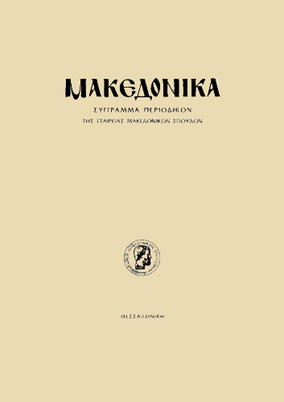Εικόνες από το εκκλησιαστικό μουσείο των Σερρών : πρώτη παρουσίαση
Part of : Μακεδονικά ; Vol.31, 1998, pages 323-344
Issue:
Pages:
323-344
Parallel Title:
Icons in the Ecclesiastical Museum in Serres : An Introduction
Section Title:
Articles
Author:
Abstract:
The collection of icons and ecclesiastical treasures on display in the Eccle siastical Museum in Serres is on the second floor of the Diocesan Centre and was put together in 1986-87 by the Metropolitan of Serres and Nigrita, Maxi- mos. The collection consists chiefly in portable icons, pieces of carved wooden sanctuary screens from local churches, ecclesiastical treasures, vestments, and liturgical fabrics either from Serres or from Nigrita and the wider area of Bisaltia. The nucleus of the Museum consists in a collection of some 130 portable icons and parts of screens that date from the late Byzantine (late 14th - early 15th cent.) to the end of the post-Byzantine period (19th cent.). They are illustrated with a variety of iconographical themes and reflect the predominant artistic trends of the major centres of the Byzantine Empire, such as Con stantinople and Thessaloniki, as also Cretan art, while others offer valuable evidence of the work of local ateliers. By way of introduction, we have elected to present a group of five important portable icons which are of use in drawing conclusions that will assist a fuller understanding of the presence, development, and evolution of painting in the Serres area and Eastern Macedonia in general, particularly in the 15th and 16th centuries. Two of the oldest icons in the collection are from the Church of St Antony in Serres and portray Christ Pantocrator and the Theotokos Hodegetria (Figs. 1, 2). They were probably painted as ‘principal icons’ (despotikes eikones) for the screen of an unknown church. Despite the overpainting on the faces, all the hallmarks of the Cretan school of painting are clearly apparent. An exami nation of their outstanding artistry leads us to similar icons of the Cretan school of the 15th century, most notably those of the celebrated painter An dreas Ritzos, and helps us to date them to the 15th century and include them in the output of this school of painting, examples of which are few and far between in Eastern Macedonia. Despite some damage and flaking of the paint film, the icon of the Panagia Hodegetria (Fig. 6) from the Monastery of St John the Baptist, Ser res, stands out for the monumentality and the inner ethos that characterises other icons of the same subject. It reveals many, chiefly stylistic, similarities to a number of icons from northern Greece and adjacent parts of the Balkan Peninsula, and this helps us to include it within the artistic output of this general area and to date it to the 16th century, closer to the first half.Another pair of icons, again probably despotikes eikones, of the Lord giving a blessing and the Theotokos Hodegetria (Figs. 10, 11), brings this brief review to a close. Stylistically, they present similar characteristics and the same technique, which suggests that they were both painted by the same artist or else by members of the same atelier, and helps to date them to the second half of the 16th or at least no later than the first decade of the 17th century. It may thus be concluded that the area of Serres and Eastern Macedonia did not remain uninvolved in the developments, the progress, and the produc tive presence of the painting of portable icons over the centuries, but rather played a fruitful part in the whole process and made a decisive contribution to its development and evolution.
Notes:
856:https://ejournals.epublishing.ekt.gr/index.php/makedonika/article/view/5693, DOI: https://doi.org/10.12681/makedonika.132
Electronic Resources:




